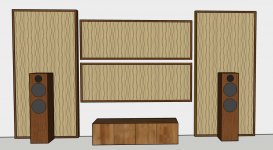William Cowan did similar-ish maybe 15ya ...
Well that's one way design solution to potentially bring diffraction down I guess. Brilliant build and nice to get the speakers hidden too. How did they image? Did they pull the trick of imaging behind the wall? @cowanaudio

I can comment regarding the imaging capabilities of in wall or soffit mounted speakers from studio monitors used in similar configurations. The imaging of such a speaker setup can be holographic and sound like the image is out in front of you closer than the speakers themselves. It really depends on power response and off axis linearity, plus the phase linearity characteristics in the critical midrange from 500 - 10k.
I've heard soffit mounted Tannoy Monitor Golds in a well known studio with highly optimized passive crossovers. Hearing them was one of the top 5 best speaker listening experiences I've had to date. They were driven by a modified Crown DC300 - not what you would consider high end by far.
I've heard soffit mounted Tannoy Monitor Golds in a well known studio with highly optimized passive crossovers. Hearing them was one of the top 5 best speaker listening experiences I've had to date. They were driven by a modified Crown DC300 - not what you would consider high end by far.
I have always thought my 1990-vintage Sennheiser HD540s have a very natural midrange. I know what you mean about midrange resolution.I always go back to the old simple, but hard to drive HD560 ovations that follow the basic inter aural resonance curve. No speaker I've heard to date can touch their midrange resoluton.
So here's a question for those in the "data is everything" camp...if you were sitting in a BLIND A-B session with say 10 well regarded hi-end speakers (for which all the necessary data was available), and had music familiar to you, and ultimately settled on one that you finally felt was the best of the 10, would you expect also that this final speaker would also have the best data? The corollary is that - if we see all the data before listening - do our expectations color our evaluations?Again, a very bad comparison. Feedback is not linear, but it requires an open loop gain, which is absent in the loudspeaker.
To me it is impossible.
We will never come to terms when you base everything on your subjective opinion. I almost never accept those - for obvious reasons. Without data people can claim anything, Like stollen elections.
weird.
tv's are cheap now..........................
and yes, a good measuring speaker that we don't love how it sounds, it can make you feel conflicted.
Honestly, speakers can be like art, they move you, emotionally.
And pick what sounds fun to you.
And play with how far you sit, it can make a big difference.
tv's are cheap now..........................
and yes, a good measuring speaker that we don't love how it sounds, it can make you feel conflicted.
Honestly, speakers can be like art, they move you, emotionally.
And pick what sounds fun to you.
And play with how far you sit, it can make a big difference.
The corollary is that - if we see all the data before listening - do our expectations color our evaluations?
Sadly, yes. But that don't make the data less useful. It just makes us human.
Around between 4min to 17 min in this video, the science on sighted vs blind listening is shown. Nothing new here, but
in my mind it tells the broad story of better measured designs are better sound for the majority of Humans. It is meaningless when inexperienced persons say they have heard the best sound from speaker or system X, while criticising a clearly better measured system.
The entire video is worth watching at least twice!
in my mind it tells the broad story of better measured designs are better sound for the majority of Humans. It is meaningless when inexperienced persons say they have heard the best sound from speaker or system X, while criticising a clearly better measured system.
The entire video is worth watching at least twice!
Last edited:
show me the data that corroborates this...More errors. These processes are completely linear.
BtW, there’s a product review video from Emir at ASR and somewhere in that video he says that he has the scientific data on room reflection preferences. This data shows that 20% of audio enthusiasts prefer a completely dead, nearly anechoic listening space and 80% prefer a certain amount of reflections.
The question is can/could one identify a system with low diffraction components verses the elliptical or spherical reduced diffraction baffle?……or could one assume that the designer voiced the crossover by ear to compensate? In other words, do no harm…..a flat flush baffle with proper driver offset and spacing is all that is required……..your listening chair is likely FAR MORE influential on your experience as is your blood pressure or if your hairstyle is obstructing your biological waveguide…..your outer ear.
- Home
- Loudspeakers
- Multi-Way
- What are some good example of baffle design to improve diffraction
